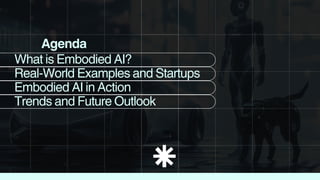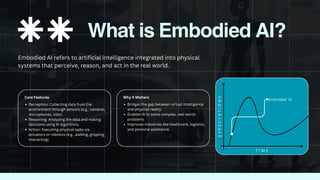Embodied AI: Bringing Intelligence to Life
- 1. Embodied AI Presented by Vadim Nareyko January 2025 What is.... Watch the Video Presentation
- 2. Agenda What is Embodied AI? Real-World Examples and Startups Embodied AI in Action Trends and Future Outlook
- 3. What is Embodied AI? Why it Matters Bridges the gap between virtual intelligence and physical reality. Enables AI to solve complex, real-world problems. Improves industries like healthcare, logistics, and personal assistance. Embodied AI refers to artificial intelligence integrated into physical systems that perceive, reason, and act in the real world. Core Features Perception: Collecting data from the environment through sensors (e.g., cameras, microphones, lidar). Reasoning: Analyzing the data and making decisions using AI algorithms. Action: Executing physical tasks via actuators or robotics (e.g., walking, gripping, interacting). E X P E C T A T I O N S T I M E Embodied AI
- 4. Real-World Examples and Startups Established Companies Innovative Startups Key Sectors Transforming with Embodied AI Boston Dynamics: Robots like Spot and Atlas for logistics and industrial tasks. SoftBank Robotics: Pepper for social and customer interaction. Amazon: Astro for home automation and security. Tesla: Advanced autopilot systems integrating Embodied AI for autonomous driving. Agility Robotics: Digit, a humanoid robot for logistics and delivery. Waymo (Alphabet): Pioneering autonomous vehicle solutions. Ava Robotics: Robots for workplace collaboration and assistance. Bear Robotics: Delivery robots for restaurants and hotels. Robust.AI: Building adaptive robotic intelligence for versatile applications. Healthcare: Surgery-assisting robots, rehabilitation devices. Logistics: Autonomous delivery and warehouse systems. Automotive: Self-driving cars and smart traffic management. Entertainment: Robots in theme parks, interactive experiences, and toys.
- 5. Challenges High Hardware Costs Developing robust robots and devices requires expensive components. Opportunities Data Processing Complexity Handling real-time multimodal data is technically challenging. Energy Consumption Power-hungry devices limit scalability and sustainability. Privacy and Ethics Concerns over surveillance and data usage in physical interactions. Real-Time Decision Making Balancing safety and efficiency in dynamic environments is difficult. Enhanced Efficiency Automating repetitive tasks increases productivity. Improved Safety Robots can replace humans in hazardous jobs. Market Growth Expanding industries like logistics, healthcare, and smart homes. Adaptability AI systems learning and evolving in real-world environments. Innovation Potential Emerging tools and solutions for seamless human- machine collaboration.
- 6. Advanced Adaptability: Robots will learn to adapt more efficiently to dynamic and unpredictable environments. Sustainability Focus: Development of energy-efficient hardware to reduce environmental impact. Mass Market Adoption: Lower costs and wider acceptance will make Embodied AI accessible to smaller companies and consumers. Collaborative Intelligence: Enhanced collaboration between robots and humans for complex tasks. Ethical Frameworks: Establishment of regulations for privacy, safety, and ethical use of Embodied AI. Integration with IoT: Embodied AI is merging with smart homes and connected devices for seamless automation. Autonomous Mobility: Expansion of self-driving cars and drones in logistics and transportation. Human-Robot Interaction: Growth in social and service robots for customer engagement and assistance. Healthcare Innovations: Use of AI in physical rehabilitation, surgery, and eldercare. Future Outlook Trends and Future Outlook Current Trends
- 7. Embodied AI is transforming industries by bridging virtual intelligence with physical action. While challenges like cost and ethics persist, advancements in hardware and adaptability promise a future of collaboration and innovation. This is not just technologyĪ¬itĪ»s a revolution in how we interact with the world. Conclusion vadim@nareyko.com linkedin.com/in/nareyko/ Watch the Video Presentation







